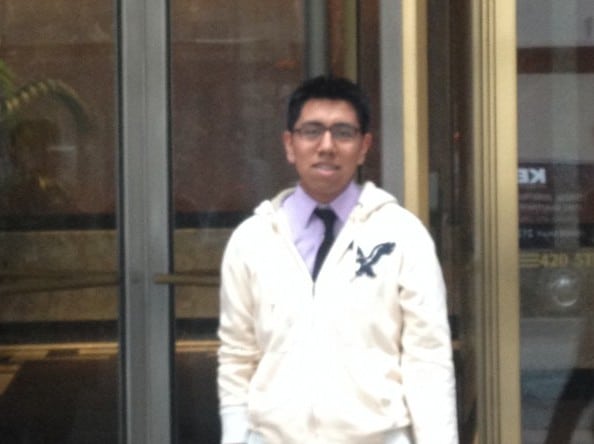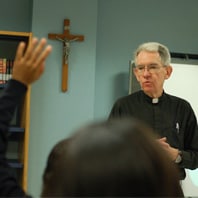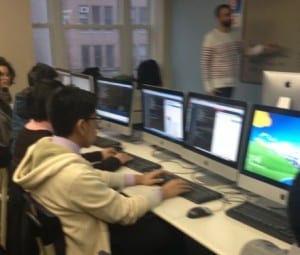March 27th, 2015 was a typical Friday for Carlos Belmont. Dressed in a neatly pressed purple shirt and a black tie, he hustled across Harlem’s Lexington Avenue, hoping to catch the 9AM 6-train. Manhattan bound.
He passed homeless men sleeping on benches, newspapers tucked around their hips. He passed a pair of Latina women preparing tamales and mole in a streetside cart. He passed a group of children playing tag in the street, slipping around traffic, ignoring the honking that followed. He passed a woman on the stoop pleading into her phone that the child support be paid.
I don’t remember this New York from the movies, I thought, as Carlos and I descended into the subway. He caught my eyes as I squeezed into the subway car between him, the crowd and the closing door, grinned at me. “Don’t want to be late for work,” Carlos said.
Twenty minutes later we emerged from beneath the earth and stepped onto Park Avenue. Women in suit pants brushed aside perfectly horizontal bangs, their words banging like snare drums into their cell phones. Men anxiously failed to hail cabs. Leather briefcases abounded.
This is it, the New York of the movies, I said to myself. The dissonance resonated in my chest.
Carlos, though, seemed just as comfortable in one world as the other. I craned my neck at the skyscrapers; the white-mirrored glass pushed the sun into my eyes. Carlos grinned, his pace quickening as we approached his workplace, The Rockefeller Foundation.
“I’m excited to have you meet the team,” he said grabbing the silvered doorhandle. “You have to meet Brenda. She has really helped me break out of my shell.” He cracks the door to the Rockefeller Foundation office and motions me inside. Business as usual.
I have already forgotten that he is only seventeen years old.
***
The story of the Cristo Rey Network is well documented. (A recap: to make a Catholic education possible for low-income families, students share a full time position at businesses throughout a metropolitan area. They attend school four days a week and their work site on the fifth. The students together earn a salary that is sent to their school to pay their tuition… all of which is explained beautifully in this video from Cristo Rey Twin Cities in Minneapolis.) Carlos Belmont attends Cristo Rey New York High School, one of the 28 “member schools” that currently make up the Cristo Rey Network.
Already one of the largest networks of Catholic schools in the country, the Cristo Rey Network is showing no signs of slowing down. Five more locations are scheduled to open in the next two years: Milwaukee and Dallas in August 2015; Baton Rouge, Phoenix, and Tampa in 2016.1 The President of Cristo Rey New York, Fr. Joe Parkes, S.J., expects that, by next year, the Network will be educating over 10,000 students across the country.
Parkes has been with the New York school since its beginning in 2004. Before joining the Cristo Rey team, Parkes worked at a number of excellent, traditional Jesuit college preparatory schools, including Fordham Preparatory in the Bronx and St. Peter’s Preparatory in Jersey City.2 Although adjusting to the Cristo Rey model was a transition for Parkes, he has found his time there particularly rewarding.
“I love working at Cristo Rey,” Parkes said, “it’s like working for a startup. There’s a freshness around here. I’ve never ceased to be impressed with the enormous amount of talent in the low-income community.” With 95% of Cristo Rey New York graduates heading to college, and 85% of those graduating, it’s hard to disagree.
***
As we entered the Rockefeller building, Carlos took me to get my visitor’s pass and stood next to me as we rode the elevator up and up. For a moment, as the New York skyline rose along with our view, the Empire State Building sleek before us, I forgot that he was in a rush. It was breathtaking.
As we entered his office Carlos took me straight to his co-workers for introductions. My first was to his supervisor, Cahaley. She’s the one who organizes his schedule and makes sure Carlos not only contributes but has the best experience possible. I shook her hand and asked her about Carlos; how he was, what his work experience was like.
“It’s important to us that Carlos is not just given busywork,” she said. “We want to make sure he knows what Rockefeller is all about and feels a part of the team.” She invites Carlos and me to breakfast before starting the day. As we turn to go she reaches out to Carlos, “Oh, by the way,” she says, “can you teach Connor how to do the pouches? He’s been wanting to learn for weeks and nobody knows but you and Brenda.” Carlos nods in agreement, smiling.
We walk. This is not a temp job, I think.
***
Carlos’s schedule varies depending upon the day. Some he spends in the mailroom, others are spent assisting with daily projects. This year Carlos has expended many hours working with Rockefeller’s Facilities and Administrative Services department, digitizing insurance certificates to make accessing and storing files easier for the company. Today would be a mix of all of these.
After breakfast, the tour continued. We passed through a hallway where hung beautiful pictures of Kenya, Thailand, and India, Carlos circumventing the cubicles of his co-workers. Finally, we land in the mailroom and are greeted with a warm smile and a soft voice singing Carlos’s praises. Meet Brenda.
“Carlos,” Brenda says, smiling as she speaks. “He’s the best that we have around here. Such a hardworking kid. He’s amazing.”
The mailroom turned out to be the perfect place to meet the FAS team, whose members periodically dropped in to send off or pick up a package. Each person, like Brenda, had a compliment for Carlos, a memory to share with me. As Carlos taught Connor how to arrange and prepare the pouches, the theme undergirding their words got clearer: having Carlos working at Rockefeller isn’t just good for him. It’s good for us.
***
Ninety-five percent head to college. Ten thousand students in the network. Eighty-five percent graduate from college. Work experience from skyscrapers that peer down at the Empire State, bearing the name “Rockefeller.” It’s impressive. But how does the Cristo Rey model affect students like Carlos in his everyday life? For one, it has helped him realize his passion: computer programming
“It began sophomore year,” he explained to me earlier, during our subway ride. “A company called Script Ed came to our school and asked if we were interested in Web Design. Only five of us showed up, but thankfully they kept coming to teach us.” Script Ed is a non-profit that connects professional computer programmers with schools that would like to teach programming but don’t have the resources. It is one of many examples of how Cristo Rey draws on the talents of the local community to contribute to the education of their students.
“I love computer programming because you get to see your own work come to life,” Carlos said. “I can look at a website I’ve designed and say, ‘I did that.’ Technology has always moved me that way.” Technology moved him, and Cristo Rey New York has given him the tools he needs to imagine a future that involves it.
Rocking back and forth in the subway car Carlos talked about that future. “One of my Script Ed teachers works for Google, and last year he took all of us to his office. He told us that the skills we are already beginning to master are pretty rare. If we want to work for a company like Google, or even start our own company, we can do it.” And he can.
***
Script Ed.
Corporate Work Study.
College-Prep curriculum.
Caring Teachers.
The Rockefeller Foundation.
This is Carlos Belmont’s Friday.
But the Cristo Rey model needs all these influences and more to do what it envisions. Fr. Parkers and Cristo Rey New York and Carlos Belmont need parents, teachers, staff, religious leaders, and business professionals. All of them. And all of them must be committed to the same thing: the education of these young people.
Spending the morning with the (almost) final product of a Cristo Rey education, a truism became true again: it takes a community to educate a child.
And it takes Carlos’s hard work, too, even with all this support. “I came to Cristo Rey for the education,” he said when I asked him about it just before lunch. “I want to go to college and, with the classes and the corporate work-study program, Cristo Rey gave me the best chance.
“My neighborhood friends always tell me it makes me seem older, having a job and looking at colleges. But at Cristo Rey, it really feels normal.”
Even at Cristo Rey the end of March is edging toward the end of the school year. And by Friday, March 27, high school seniors have started to hear from colleges admissions departments across the country. Carlos has too. Admissions envelopes have come in from the University of Scranton, Renssellauer Polytech, the Rochester Institute of Technology, and Fordham University.
All of them have said yes.
– // –
(Editor’s Note: This is the second in a series of articles Dan is writing that highlight a particular school model. This article highlights the work of Cristo Rey New York. To learn more about the Fe y Alegría network in South America, click here.)


